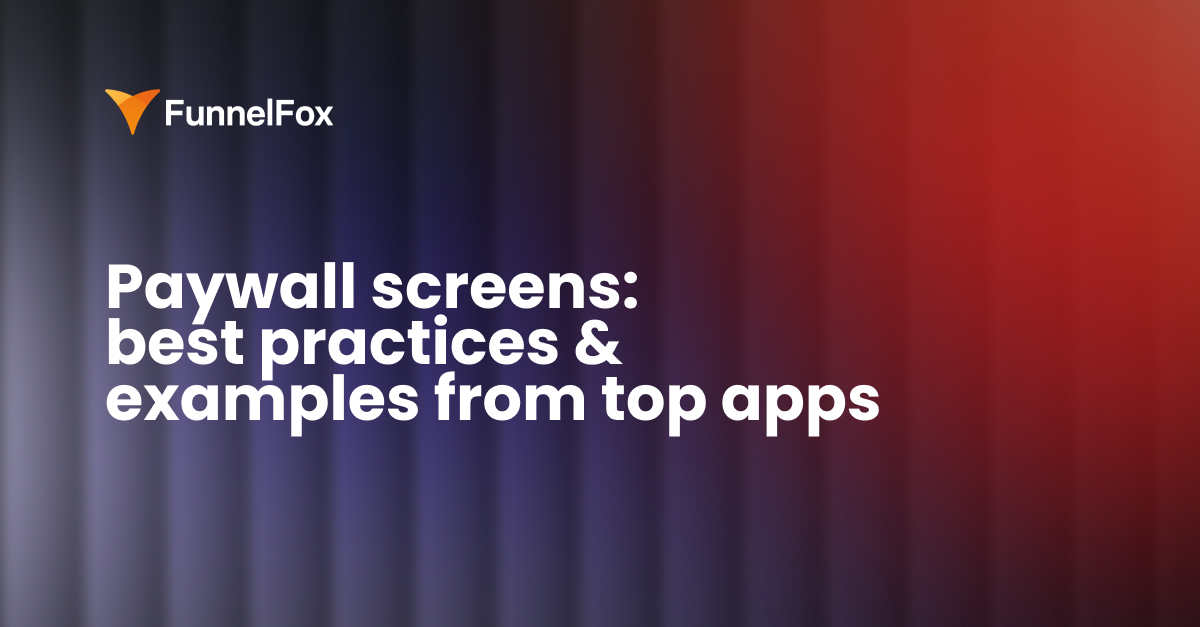Pricing an app sounds simple. Pick a number, stick it on the paywall, done. Right? Not even close. Set it too low and you look cheap, leaving serious money on the table. Set it too high and conversions collapse, dragging your reviews down with them. App pricing is one of those decisions that feels small, but it shapes whether your app scales or stalls.
That’s why the best teams don’t treat app pricing as a guess — they treat it as a strategy.
In this article, we’ll go through the five most common methods to determine the right price for an app. For each one, we’ll cover the core idea, the upsides and downsides, when it works best, and the practical steps to put it into action.
But first, save this one-page cheat sheet of app pricing models. Keep it in your toolkit — it’s a quick reference for the what, the why, and the when of each method.
| App pricing model | Core idea | Pros | Cons | Best fit | When to use |
|---|---|---|---|---|---|
| Competitor-based | Set your price by looking at competitors in your category and region | • Simple and fast • Matches market expectations • Works well in mature categories | • Ignores your unique value • Can trap you in market “norms” • Geographic mismatches | Mass-market categories (fitness, meditation, utilities), early monetization stage | At launch — to enter the market quickly without scaring users off with an odd price |
| Value-based | Price is set by the value your product creates for the user (savings, benefit, outcome) | • Maximizes margin • Easy to justify to users • Works for both B2C and B2B • Keeps team focused on value | • Requires research • Value is subjective • Market may not be “ready” • Harder to align internally | Premium segments (health, education, finance), products with a unique value prop | When the product is mature and value is proven — lets you charge above market without hurting CR |
| Psychological | Use perception effects like .99 pricing, anchoring, “best deal” framing, or comparisons (“less than $0.20/day”) | • Easy optimization • +3–10% CR boost “almost for free” • Works especially well on first contact • Flexible and quick to test | • Doesn’t replace a real pricing strategy • Impact may be weaker in mature markets (e.g., U.S.) • Risk of looking manipulative if overused • Potential regulatory scrutiny | Mass-market B2C apps, paywalls with multiple plans, geos sensitive to symbolic pricing | At any stage as tuning to lift CR without changing core economics |
| Experiment-driven | Treat price as a hypothesis — set different prices/plans, test on real users, and double down on the winner | • Maximum objectivity • Often uncovers hidden opportunities • Flexible for segments and geos • Syncs well with marketing tests | • Needs significant traffic • Resource-intensive and time-consuming • App Store/Google Play restrictions • Risk of lost revenue if a test fails | Apps with high traffic, scaling products, global reach | When you have volume — post-MVP, during scaling, to find the optimal ARPU/LTV |
| Tiered / Multi-plan | Offer multiple plans (Monthly vs Annual, Basic/Pro/Premium, Family/Individual); gives users choice and creates anchoring | • Captures different segments • Increases ARPU • Lets users downgrade instead of churning • Highlights the “best deal” | • More complex to manage • Risk of cannibalization • Can confuse users if too many plans • Needs fair value splits | Apps with broad audiences, premium segments, family use cases | When the product is growing and you need segmentation, upsell, and retention |
1. Competitor-based pricing: anchor your price to market averages
Competitor-based pricing is one of the simplest ways to start. Instead of reinventing the wheel, you look at what similar apps in your category are charging and set your price in the same ballpark. Sometimes that means matching their subscription exactly, and sometimes, coming in a little cheaper to speed up early conversions.
For example, if the top meditation apps in the U.S. price annual subscriptions at $60–70, dropping to $30 a year looks suspicious (“the content must be worse”), while asking $120 is risky (“too expensive for this segment”).
Pros:
- Quick and easy — you don’t need surveys or research, just a sweep through the app stores and tools like SensorTower or AppMagic.
- Matches market expectations, so users aren’t shocked by your price.
- Works well in mature verticals like fitness, meditation, productivity, and utilities, where tiers are already established.
Cons:
- Ignores your unique value — if your app is worth more but you stick to the same price, you lose money.
- Lacks flexibility — markets sometimes get stuck at suboptimal price points, and copying keeps you stuck too.
- Geographic mismatches — a price that feels fair in the U.S. may flop in India or Latin America. Blindly copying global competitors can set you up for failure in local markets.
- Vulnerable to big players — if Apple Fitness+ comes in at $10/month, it’s tough for a smaller startup to justify $15.
Where it works best
Competitor-based pricing is a solid starting point when you’re launching monetization and don’t yet have your own ARPU or willingness-to-pay data. It also works well in mass-market categories where users already have clear price expectations, or when your product is a close alternative to a market leader and your main edge is convenience or cost.
How to set your price based on competitors
Step 1: Define your comparison set
Decide your category, audience, platform, and top markets. Clarify if you’re subscription-only, subscription + lifetime, or hybrid. This becomes your baseline for fair comparison.
Step 2: Collect competitor data
Pick direct and near-direct competitors across leader, mid-tier, and budget levels. Record their weekly, monthly, and annual prices, free trials, intro offers, and how their paywalls are structured (anchors, “best value” badges, locked features).
Step 3: Benchmark and position
Normalize prices into USD, calculate medians and ranges for each market, and see who’s premium (>1.2× median) and who’s budget (<0.8×).
Then decide whether to stay close to the median (safe start), undercut slightly to win conversions, or go premium (but only if you can back it up with real value). Avoid extremes unless you have strong evidence.
Step 4: Build and test your plans
Offer monthly and annual by default, add weekly only if you can handle churn, and price lifetime at 2.5–3× annual to protect LTV. Use anchoring: put annual in the center, mark it as “Best value,” and make it the default.
Then A/B test small price changes, trial lengths, or paywall layouts — and watch not just conversion, but churn, refunds, ARPU, and LTV.
Step 5: Check unit economics
Confirm that expected LTV comfortably exceeds CAC (e.g., 3×). If conversion drops so far that LTV no longer covers CAC, adjust pricing or improve onboarding.
Step 6: Localize and re-benchmark
Adjust pricing with App Store/Google Play tiers or PPP coefficients so you stay consistent across markets. Watch psychological thresholds in local currencies (like 39.99 zł vs 44.99 zł).
Keep monitoring competitor paywalls weekly and refresh your benchmarks monthly.
Quick tips:
- Don’t be the cheapest unless you have a clear reason — it hurts brand perception and makes future price hikes harder.
- Test weekly plans separately. They bring fast cash but also high churn and refund risk.
- Keep lifetime pricing at least 2.5× the annual plan, or you’ll eat into your future revenue.
- When you adjust pricing, update your paywall messaging too — highlight benefits, social proof, or comparisons.
- Always keep monthly and annual in a logical ratio so the annual plan looks like a genuine deal, not a trick.
2. Value-based pricing: tie your price to the value you deliver
Value-based pricing takes a different angle: instead of copying competitors or covering your costs, you set your price based on the value your app creates for users.
The question becomes: How much is this outcome worth to them, and what portion of that value are they willing to pay?
For example, a language-learning app that saves $200–300 a month on tutors can justify $10–15 per month. Or a fintech tool that helps users cut $100 in monthly fees can easily charge $20.
Pros:
- Maximizes margin — if the perceived value is high, you can price above the market.
- Easier to justify to users — “we save you $200, so $15 is a fair deal” is stronger than “that’s what everyone charges.”
Cons:
- Requires research — without surveys or interviews, you risk over- or underpricing.
- Value is subjective — $15 feels cheap to one user and expensive to another, so segmentation is key.
- Market readiness — if competitors cluster at $5, asking $20 is risky even if value is there, especially in price-sensitive regions.
- Harder to align internally — product and marketing both need to deliver and explain the value story.
Where it works best
Value-based pricing is most powerful in premium segments like health, fitness, education, and finance, where users see clear ROI (healthier, wealthier, smarter, more productive). It’s also effective in high-LTV niches (such as career-focused learning, investing, or mental health apps) or when your app has a unique value proposition that can’t be compared 1:1 with competitors.
How to implement value-based pricing
Step 1: Define the value you create
Pin down what outcome your app delivers — saving time, money, effort, or delivering results faster or better. Identify user alternatives (a tutor at $30/hour, a gym membership at $50/month, a lawyer at $200 per consult). Frame it as the job your app gets done.
Step 2: Measure willingness to pay
Use techniques like:
- Van Westendorp — four questions (“too cheap,” “cheap,” “expensive,” “too expensive”) to reveal the acceptable price range.
- Gabor-Granger — test purchase intent at different price points.
- Conjoint analysis — for bigger teams, to uncover trade-offs between features, terms, and price.
- JTBD interviews — ask what they spend on alternatives and what price feels fair.
In practice, most apps combine Van Westendorp with user interviews to get enough signal.
Step 3: Segment your audience
Early adopters usually pay more; the mass market pays less. Willingness to pay is higher in the U.S. and Western Europe than in India or LATAM. iOS users almost always show higher ARPU than Android.
Instead of one flat price, set differentiated tiers by region, plan type, or subscription length.
Step 4: Build a value-to-price model
Estimate the savings or revenue your app delivers. Decide what share of that value users are likely to pay (often 5–20%). Turn that into a price hypothesis and test it.
Step 5: Validate with real behavior
Surveys and interviews only go so far. End with an experiment: launch paywalls with different prices and measure not just conversion, but retention and LTV. The real proof of value is whether users actually pay and stay.
Quick tips:
- Anchor your price to clear ROI — “we save you $200, we charge $20.”
- Don’t rely only on surveys — always test with real transactions.
- Avoid one-size-fits-all pricing — segment by region and platform.
- If you’re asking far above the category average, double down on value communication in onboarding and paywall copy.
3. Psychological pricing: use perception to make prices feel right
Psychological pricing taps into how people perceive numbers rather than what the math says. The classic move is $9.99 instead of $10 — but in mobile apps, the toolkit goes much further. Common tactics include:
- Charm pricing ($9.99 instead of $10)
- Decoy effect (three tiers where the middle looks like the smart choice)
- Anchoring (annual vs. monthly side by side to make the annual plan feel like a bargain)
Pros:
- Works almost universally — influences perception without changing the economics.
- Subtle tuning — even a .99 ending can lift conversion by 3–7%.
- Flexible — you can test small tweaks without reworking the whole model.
- Especially powerful at first contact (onboarding, trial → subscription).
Cons:
- Not a strategy on its own — if the price is fundamentally off, .99 won’t save it.
- Not equally effective everywhere — charm pricing is less effective in mature markets like the U.S., but still strong in Asia/LatAm.
- Risk of distrust if overused (too many tricks, constant discounts).
- Regulatory pressure — in the EU and UK, rules on “fake” discounts are tightening.
Where it works best
Psychological pricing shines in verticals such as fitness, meditation, or utilities, where users are used to scanning prices quickly rather than calculating ROI. It’s especially effective in regions that are highly sensitive to symbolic numbers like India, Latin America, or Eastern Europe. And if your app uses multi-tier paywalls, these tactics help steer users toward the “best deal” plan without changing the actual economics.
How to implement psychological pricing
Step 1: Establish your baseline price
Start with competitor or value-based benchmarks. Psychological tweaks layer on top of a solid price, not instead of it.
Step 2: Choose your number format
- Charm pricing: $9.99 instead of $10 (most common).
- Prestige pricing: round numbers ($100, $50) — works for premium or B2B.
- Even-ending discounts: $4.95, which feels honest and exact.
- Left-digit effect: $19.99 is read as “nineteen,” not “twenty.”
Step 3: Frame the choice with anchors and “best deal” cues
Frame your price with higher-priced options. A $199 lifetime plan makes $59.99/year feel cheap. A $9.99 monthly side-by-side with $59.99 annual makes the annual look like a steal.
Mark your preferred plan as Best Value or Most Popular. Put annual in the center, color it differently, and show a clear savings percentage — but keep it real, not artificial.
Step 4: Add trust-building context
Reframe your price in relatable terms (“less than a coffee a week” or “under $0.20 a day”) and avoid forcing users to do math. Display annual totals clearly instead of just monthly multiples.
Step 5: Test and track impact
Run A/B tests on number endings, layout, and framing. Monitor not just paywall conversion, but also churn, refunds, and retention, because psychological tricks only work if they hold up over time.
Quick tips:
- Treat psychological tactics as an add-on, not the foundation — they only work if your base price is solid.
- Keep it subtle — one or two nudges build trust, too many feel manipulative.
- Always test locally — what works in the U.S. may flop in Europe or shine in Asia/LatAm.
- Watch the long game — a flashy lift in conversions is useless if refunds and churn spike later.
4. Experiment-driven pricing: when tests, not guesses, set your price
Experiment-driven pricing relies on real user behavior instead of competitor benchmarks or survey answers. You try different price points, plan structures, or paywall designs, measure what drives the best LTV and retention, and double down on what works.
Common tools include paywall A/B tests, geo-based price tests, and elasticity modeling.
Pros:
- Maximum objectivity — you see what users actually do, not what they say.
- Surprising upside — people often pay more than you expect.
- Flexible — prices can be adapted by geo, platform, or cohort.
- Marketing sync — you can test prices alongside creatives and promos.
Cons:
- Requires traffic — 100 purchases won’t give you valid stats.
- Time- and resource-heavy — proper A/B testing needs volume, tooling, and patience.
- App store constraints — Apple and Google require consistent in-app pricing. Workarounds include testing paywall design (showing different plan mixes) or using web2app funnels, where pricing is more flexible.
- Risk of missteps — a poorly designed test can hurt ARPU.
Where it works best
Experiment-driven pricing works best for apps with large traffic bases (1M+ MAU), where data accumulates quickly. It’s especially suited to subscription apps in mature categories like fitness, education, meditation, or utilities. This app pricing model also shines for products at the scaling stage, where squeezing more from paywalls matters most, and for global apps, where geo-pricing differences can be validated directly.
How to implement experiment-driven pricing
Step 1: Define clear hypotheses
Start with focused questions: Will $7.99/month perform as well as $6.99 but improve LTV? Will adding a $59.99 annual option increase the annual share? Keep it measurable.
Step 2: Set up your testing framework
Put analytics and infrastructure in place. Decide how you’ll split users (by geo, platform, or device) and which metrics really matter — not just conversion, but retention, refunds, ARPPU, and LTV.
Step 3: Design and run tests
Choose your format — paywall A/B, multivariate, geo-based, or web2app vs. direct-to-app experiments. Run the test long enough to get meaningful data (1–2 weeks for fast-moving categories, 4–6 weeks for subscription flows with trials).
Aim for statistical confidence — p<0.05 is the gold standard, though in mobile, many teams act once results look “confident enough” in practice.
Step 4: Analyze beyond surface metrics
Look past raw conversion rates. Sometimes CR dips, but ARPPU and LTV rise. Balance across the funnel: acquisition–conversion–retention–revenue.
Step 5: Roll out winners and evolve
Push the best variant live, then form the next hypothesis. Keep iterating in small increments (about $1–2 monthly and $5–10 annually) and layer in new plan types like multi-year or family options. Over time, this builds a system of continuous price evolution.
Quick tips:
- Never run tests without enough traffic, or you’ll draw false conclusions.
- Measure long-term LTV, not just immediate conversion.
- Use web2app if you need pricing flexibility outside app store rules.
- Think of this as the core optimization method: competitor-, value-, and psychological-based pricing all feed hypotheses, but only experiments reveal what really works.
Experiment-driven pricing is the ultimate monetization strategy. Competitor-, value-, and psychological-based approaches all give you starting hypotheses, but only real-world experiments reveal the price that truly works.
5. Tiered or multi-plan pricing: Capture different segments with one product
Instead of offering a single price, tiered pricing gives users multiple options — different features, terms, or user counts.
Common formats include:
- Monthly vs. annual (the classic)
- Basic / Pro / Premium (feature-based tiers)
- Individual / Family / Business (by number of users)
The goals are threefold: cover different audience segments (price-sensitive vs. premium), use anchoring so the middle plan feels like the smart choice, and lift ARPU through upsells.
Pros:
- Maximum flexibility — one product, multiple segments.
- Psychological advantage — users often pick the middle plan when given 2–3 options (the decoy effect).
- Higher ARPU — a portion of your audience upgrades to premium.
- Lower churn — some users downgrade instead of canceling entirely.
- Easier to test — you can adjust plan structure, not just prices.
Cons:
- Harder to manage — more analytics needed.
- Risk of cannibalization — if Premium is too generous, Pro becomes irrelevant.
- Potential confusion — more than 3–4 plans can overwhelm and hurt CR.
- Requires honest value splits — if features are cut artificially, UX suffers.
Where it works best
Tiered pricing works well for apps with broad audiences — fitness, learning, productivity — where different users pay differently. It’s also useful in prosumer or B2B-style mobile apps, in family or shared scenarios like meditation or music, and in high-ARPU categories, where premium plans can justify custom pricing.
How to implement tiered / multi-plan pricing
Step 1: Define your segments
Identify at least three types of users: those who want the cheapest way in (Basic), those who need the full product (Pro), and those willing to pay extra for perks (Premium). Base this on interviews, usage patterns, or willingness-to-pay data.
Step 2: Decide the number of plans and structure the packages
Two plans keep things simple, three (Basic / Pro / Premium) usually work best, and more than four only if you truly serve distinct groups like Individual, Family, and Business.
Give Basic the essentials, unlock everything in Pro, and add extras to Premium (family access, exclusive content, coaching). Keep annual pricing at 6–8× monthly.
Step 3: Guide choice with anchoring and paywall design
Position the middle plan as the best deal. Use the top-tier plan as a reference point.
On the paywall, make comparisons easy with a simple table, highlight “Most Popular,” and put the annual plan in the center with a Best Value badge.
Step 4: Test and track performance
Experiment with the number of plans, feature splits, and Premium pricing. Monitor conversions, ARPU, churn, and especially movement between plans — upgrades, downgrades, and retention by tier.
Step 5: Revisit your setup every six months
Add value to Premium to keep it attractive, and adjust by market — three tiers may be right in the U.S., while two may be enough in India.
Quick tips:
- Three plans (Basic / Pro / Premium) usually hit the sweet spot — enough choice without confusion.
- Always show clear value differences between tiers — don’t cut features arbitrarily.
- Use Premium either as a true revenue driver or as an anchor, but know which role it plays.
- Track not just CR but plan shifts — downgrades can save users you’d otherwise lose.
Other app pricing models (less common but useful)
Not every pricing model fits into the big five. Here are several additional app pricing models you’ll see in the wild. They’re rarely standalone plays, but they can add value when layered on top of the core app pricing models.
6. Penetration pricing
Idea: Launch with a very low price to quickly attract users and gain market share, then raise it later.
Pros: Fast growth, high conversion rates.
Cons: Hard to raise prices later without backlash; users get “trained” to expect cheap.
Best for: Early-stage startups in hyper-competitive categories where scale matters most.
7. Skimming pricing
Idea: Start high, target early adopters willing to pay more, then gradually lower the price as the market broadens.
Pros: Maximizes revenue from loyal or high-income users; creates a premium brand image.
Cons: Risk of missing critical mass; harder to justify price drops later.
Best for: Unique or innovative products, status-driven niches (e.g., cutting-edge AI apps).
8. Localized pricing
Idea: Adjust pricing for each region based on currency and purchasing power.
Pros: Boosts conversion in price-sensitive markets; feels fairer to users.
Cons: More complex billing; risk of “arbitrage” (users finding cheaper markets).
Best for: Global apps (fitness, utilities, education). A must-have once you scale internationally.
9. Advanced research methods
Thinks of Van Westendorp (maps the range between “too cheap” and “too expensive”), Gabor-Granger (tests purchase intent at multiple price points), and conjoint analysis (models trade-offs between features, terms, and price).
Pros: Delivers precise willingness-to-pay insights.
Cons: Expensive, slow, and requires expertise.
Best for: Larger companies with research budgets, building long-term pricing strategies.
10. Lifetime / Founders pricing
Idea: Offer lifetime access for a one-time payment, or deeply discounted plans for early adopters.
Pros: Quick cash flow, creates a loyal base, strong marketing effect (“early users for life”).
Cons: Caps future revenue, can hurt unit economics if overused.
Best for: Indie apps, early-stage launches, crowdfunding campaigns.
These methods almost never stand alone. They usually act as add-ons:
- Competitor + localized
- Value-based + experiment-driven + advanced research
- Tiered + penetration / skimming (at different growth stages)
Wrap-up on app pricing models
There’s no universal formula for pricing a mobile app. What matters is creating a process, not a snapshot — a system where pricing is tested, refined, and adapted as your product and audience evolve.
A strong app pricing model balances three forces: the market you’re in, the value you deliver, and the behavior of real users. It’s about finding the sweet spot where growth, retention, and revenue reinforce each other. That means your first price is only a hypothesis. The real work comes in running pricing experiments, learning from the data, and adjusting over time.
Done well, pricing becomes more than a number on a paywall — it turns into a growth lever that signals quality, builds trust, and maximizes lifetime value.









